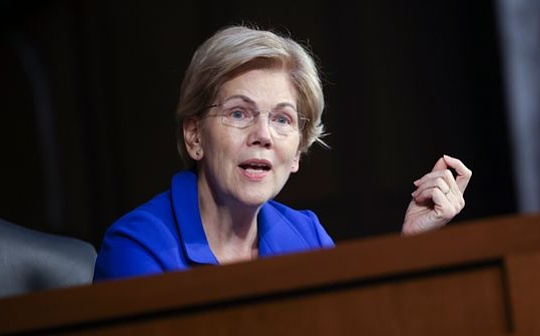
Author: Elizabeth Warren; compiled by Deng Tong, Bitchain Vision
After the European Central Bank and the Bank of Canada have taken the lead in cutting interest rates, the Federal Reserve does not seem to have plans to cut interest rates.U.S. Senator Elizabeth Warren wrote a letter to Jerome Powell, chairman of the U.S. Federal Reserve System, to illustrate his position on the current U.S. monetary policy, and noted that the Federal Reserve’s monetary policy does not help reduce itInflation – is pushing up housing and auto insurance costs.And current monetary policy may lead to an economic recession, leaving thousands of American workers unemployed.Bitchain Vision translates the original text of the letter as follows for readers.
Dear Chairman Powell:
We wrote today to urge the Federal Reserve to lower the federal funds rate from its current 20-year high of 5.5%.Continuous high interest rates have led to slowing economic growth and have failed to address the remaining key drivers of inflation.
In addition, the European Central Bank (ECB), like the Federal Reserve, has also shouldered the mission of guiding inflation to its 2% target, and the bank cuts interest rates for the first time in five years.Now is the time for the Fed to take the same action.Major central banks have cut interest rates or tend to cut interest rates.The ECB cut interest rates from 4% to 3.75% on Thursday.
On Wednesday, the Bank of Canada cut interest rates, becoming the first country in the G7 (G7).Sweden, Switzerland, Hungary and the Czech Republic have cut interest rates.The Fed decided to maintain high interest rates and continue to widen the interest rate gap between Europe and the United States, as lower interest rates could push up the dollar and tighten financial conditions.
The Fed’s current interest rate policy also has an effect that is contrary to its expected effect: it pushes up housing and auto insurance costs, which were the main drivers of overall inflation before.In fact, “excluding housing, overall personal consumption spending (the Fed’s preferred inflation indicator) will grow 1.8% in April, below the Fed’s target… More importantly, personal consumption spending that does not include housing has been in place since OctoberAlways staying at 2% or lower.”
This housing-related inflation is directly driven by high interest rates:Reducing interest rates will reduce the cost of renting, buying and building houses, and reduce the biggest monthly expenditure for Americans.Lowering interest rates may also reduce the cost of auto insurance, and the increase in the cost of auto insurance is entirely due to factors that are not related to the cost of loans.
In addition to having the opposite effect as expected, the Fed’s decision to maintain high interest rates continues to threaten the economy.Many economists agree that “inflation has fallen enough to allow the Fed to start cutting interest rates so as not to cause more serious economic damage.”
Mark Zandi, chief economist at Moody’s Analytics, stressed that “these (high interest rates) rates are like economic corrosion.”Agent; You know, they will drag down the economy, and at some point, the economy may collapse.” In addition, Zandi urged everyone not to “sacrifice the economy for the 2% target”, noting that while the number of layoffs is currently small, “this is the next step for the company.”JPMorgan analysts believe that the Fed’s current interest rates may even fuel inflation, and prices will stabilize only if the central bank begins to cut interest rates.
Participants at the FOMC May meeting also noted that “high interest rates could lead to fragility in the financial system.”
Housing inflation accounts for a large part of the Consumer Price Index (CPI), and high interest rates cause housing costs to rise rather than fall.High interest rates have pushed up rents, mortgages and construction costs, limiting housing supply and causing prices to remain high.Zandi stressed that if “the rent for single-family homes is removed from the Fed’s preferred price indicator, inflation is already below 2%.
The core issue is “The Fed’s interest rate tool doesn’t match housing inflation, and, if anything, is it aggravates housing inflation.”Single-family home inventory has dropped 75% from its peak of 4 million units, and is currently about 1 million units.Higher interest rates are particularly bad for young people (ages 18-35) who are trying to become homeowners, a age group that has dropped by nearly 10% compared to previous generations of young people.Lower mortgage rates will encourage more people to sell their homes, which in turn will increase housing supply, lower prices, reduce rental costs, and ultimately increase home ownership.
High interest rates have also further increased construction costs, resulting in developers canceling, significantly postponing or shelving projects across the country, “increasing housing shortages by increasing credit costs for builders and developers.”The U.S. is already facing severe housing shortages, which the Fed refuses to lower interest rates exacerbates and pushes up inflation.
The Fed rate hike doesn’t seem to be the wrong tool to lower other inflation drivers, such as auto insurance.If auto insurance is excluded, overall inflation will be “only half a percentage point lower” than the Fed expects 2%.But the increase in motor vehicle insurance costs reflects a variety of factors, including a shortage of mechanics, more severe and frequent car accidents, climate change that causes more vehicles to be damaged by extreme weather, and more complex and more costly maintenance cars.High interest rates cannot mitigate all of these factors.In fact, the Fed’s rapid rate hike in 2022 may have had the opposite effect than it expected, prompting insurers to raise premiums.According to an analysis:
This could also be another area where the Fed rate hike could exacerbate the problem.Insurance companies invest premiums as “floating capital” before they need to pay the claim.When interest rates start to rise, insurance companies are in trouble because of investing in long-term securities and eventually lose money.In other words, industry losses have nothing to do with rising car repair costs in some sense, but rather with their own poor investment strategies.
The Fed’s monetary policy does not help reduce inflation.In fact, it is pushing up housing and auto insurance costs — two main drivers of inflation — threatening economic health and potentially leading to a recession, forcing thousands of American workers to lose their jobs.You’ve kept interest rates too high for too long: it’s time to cut rates.
Thank you for your attention to this matter.
Elizabeth Warren








